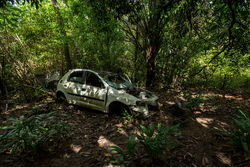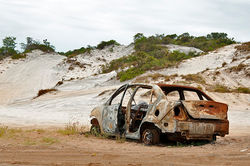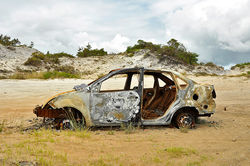 |  |  |
|---|---|---|
 |  |  |
 |  |  |
 |  |  |
 |  |  |
 |  |  |
 |  |  |
 |  |  |
 |  |  |
 |  |  |
 |  |  |
 |  |
Descartáveis
A partir do momento que começo a sistematizar a captura de imagens dos carros “desovados”, o sentimento de contemplação da natureza dá lugar a outro tipo de compreensão a respeito da paisagem, que deixa de ser apenas uma extensão geográfica territorial para se tornar uma percepção da sociedade contemporânea na qual, evidencia seus processos de produção de bens e consequentemente a normatização de uma cultura consumista e desumana. Neste sentido, o ensaio Descartáveis propõe outro olhar aquém do espetáculo da beleza do espaço natural. A paisagem romântica, ligada ao sublime, a pureza da flora é suprimida pelo realismo sórdido dos atos criminosos e violentos, representados pelas carcaças deixadas nas dunas, parques e nas margens das estradas. Embora a natureza esteja inserida objetivamente na cena, sua presença enreda uma distopia decorrente dos descartes de automóveis revelando uma visão da barbárie humana. A experiência de um “estado de alma” resultante da contemplação e da presença do corpo no espaço cede a uma visão sombria associada a sentimentos de incertezas e obscuridade.
No ensaio, uma dicotomia entre o sublime da natureza e os carros descartados entra em uma espiral complexa de impressões e associações. Se, por um lado, o revelo topográfico e a diversidade da fauna despertam uma contemplação, por outro, as carcaças exibem um desfecho violento que marca negativamente a região como lugar perigoso. Mas esse contraste também é amenizado quando os veículos começam a se desfragmentar pela ação das intempéries e o crescimento da vegetação acaba por fundir o meio ambiente ao rejeito urbano. Em algumas imagens, a pátina do tempo vai ocultando, silenciando o descarte abrupto. A carcaça enferrujada mescla-se ao barro vermelho da terra. Ocupa e toma o espaço à força, igualmente a uma planta que brota entre as frestas das calçadas nos centros urbanos, adaptando-se ao progresso. Hoje, os dejetos são partes das paisagens transfiguradas, exibem seus corpos como animais moribundos em um bioma malévolo. Este novo ecossistema enfermo já está bem-adaptado e desenvolvido no cenário antropogênico da Bahia. Vida e rejeitos lutam e convivem em um horizonte nebuloso.
A tonalidade da luz reflete a busca por uma unidade visual que traduza a textura da matéria: a ferrugem oriunda do fogo, a carcaça amassada pelo impacto, os resíduos carbonizados sobre a terra são mais que elementos estéticos, funcionam como índices patológicos sociais. Neste sentido, o tempo nublado e o mormaço contribuem para criar uma atmosfera tensa, projetando nas imagens um clima mais dramático à cena do crime. A temperatura de cor fria evoca uma serenidade ambígua, um silêncio que contrasta com a ação dos meliantes durante os descartes. Para conseguir uma harmonia de cor e a luz desejada, retornei repetidamente ao mesmo veículo. Permaneci no local o tempo necessário para obter uma imagem que satisfizesse minha projeção, negligenciando em algumas ocasiões minha segurança, uma vez que fui alertado por moradores e transeuntes dos riscos iminentes. Entretanto, a vontade de colecionar, formar uma tipologia distópica tropical que evidencia a insanidade e esquizofrenia social foi mais forte. Por dez anos venho construindo estas imagens, das vinte apresentadas, apenas quatro não são inéditas. As mais recentes são de 2025, tiradas no Recôncavo Baiano.
Disposables
From the moment I begin to systematize the capture of images of "spawned" cars, the feeling of contemplation of nature gives way to another kind of understanding about the landscape, that it ceases to be only a geographical territorial extension to become a perception of the contemporary society in which, evidences its processes of production of goods and consequently the normalization of a consumerist and inhuman culture. In this sense, the essay Disposable proposes another look behind the spectacle of the beauty of the natural space. The romantic landscape, linked to the sublime, the purity of the flora is suppressed by the sordid realism of criminal and violent acts, represented by carcasses left in the dunes, parks and roadsides. Although nature is objectively inserted in the scene, its presence entangles a dystopia resulting from the discards of automobiles revealing a vision of human barbarity. The experience of a "state of soul" resulting from contemplation and the presence of the body in space gives way to a dark vision associated with feelings of uncertainty and obscurity.
In the essay, a dichotomy between the sublime of nature and discarded cars enters a complex spiral of impressions and associations. If, on the one hand, the topographical revelation and the diversity of fauna awaken a contemplation, on the other hand, the carcasses present a violent outcome that negatively marks the region as a dangerous place. But this contrast is also attenuated when vehicles begin to defragment by the action of time and the growth of vegetation ends up merging the environment with urban waste. In some images, the patina of time is hiding, silencing the abrupt discard. The rusty carcass merges with the red clay of the earth. It occupies and takes space by force, also a plant that sprouts between the cracks of the sidewalks of urban centers, adapting to progress. Today, the droppings are part of the transfigured landscapes, displaying their bodies like dying animals in a malevolent biome. This new sick ecosystem is already well adapted and developed in the anthropogenic scenario of Bahia. Life and rejections struggle and coexist in a cloudy horizon.
The hue of light reflects the search for a visual unit that translates the texture of matter: the rust from fire, the shell crushed by impact, the charred residues on the earth are more than aesthetic elements, they function as social pathological indices. In this sense, cloudy weather and heat contribute to create a tense atmosphere, projecting on the images a more dramatic climate at the crime scene. The cold color temperature evokes an ambiguous serenity, a silence that contrasts with the action of the mischievous during the discards. To achieve a harmony of color and the desired light, I repeatedly returned to the same vehicle. I remained in the place the necessary time to obtain an image that would satisfy my projection, neglecting on some occasions my safety, since I was alerted by residents and passers-by of the imminent risks. However, the desire to collect, form a tropical dystopian typology that highlights insanity and social schizophrenia was stronger. For ten years I have been building these images, of the twenty presented, only four are not unpublished. The most recent ones are from 2025, taken in the Recôncavo Baiano.





